
| WWT Shows | CLICK TO: Join and Support Internet Horology Club 185™ | IHC185™ Forums |

|
• Check Out Our... • • TWO Book Offer! • |
Welcome Aboard IHC185™  Internet Horology Club 185
Internet Horology Club 185  IHC185™ Discussion Site Main Page
IHC185™ Discussion Site Main Page  Horological Discussions, Questions and Answers
Horological Discussions, Questions and Answers  Pocket Watch Discussions
Pocket Watch Discussions  Brotherhood of Railroad Trainmen, 1921 dues receipt
Brotherhood of Railroad Trainmen, 1921 dues receipt
 Internet Horology Club 185
Internet Horology Club 185  IHC185™ Discussion Site Main Page
IHC185™ Discussion Site Main Page  Horological Discussions, Questions and Answers
Horological Discussions, Questions and Answers  Pocket Watch Discussions
Pocket Watch Discussions  Brotherhood of Railroad Trainmen, 1921 dues receipt
Brotherhood of Railroad Trainmen, 1921 dues receiptGo  | New Topic  | Find-Or-Search  | Notify  | Tools  | Reply to Post  |  |
Picked this up the other day and was fun to see it. Official dues receipt for the Brotherhood of Railroad Trainmen from Saskatoon, North West Hub, Saskatchewan, Canada. Dues for Dec., 1921, member E. Olson, Lodge No. 783 Treasurer Collector, H.L. Raymes | |||
|
Receipt | ||||
|
2 | ||||
|
3 | ||||
|
4 | ||||
|
5, back of receipt | ||||
|
6, back of receipt again | ||||
|
| IHC Member 1291 |
Nice piece of RR trivia/history !! regards, bb | |||
|
| IHC Member 1541 |
Yup, nice bit off ephemera, I am sure Larry Buchan will find it interesting. I thought it said SECRET WORD and PASSPORT but it is WORK. Perhaps Larry will have an explanation. | |||
|
Buster,Lorne - thanks. Yes, "secret work" is interesting, perhaps a wee bit of covert work in the mix back then. For a short paragraph it is pretty prescriptive regarding eligibility and various positions within the Union to authorize for "secret work" I hope Larry does see this and can shed some light on the situation. Rick | ||||
|
| IHC Member 1955 |
Rick, that's an incredible piece. There are some old RR receipts and bonds floating around on Ebay and I've a serious mind to start collecting them. I'd love to hear from Larry B. on this one too! | |||
|
| IHC Member 1291 |
The "secret work" is just that, very secret and cannot be made public; Brotherhood of Railroad Trainmen This important fraternal society, originally known as Brother- hood of Railroad Brakemen, was established at Oneonta, N. Y., in 1883, as "a voluntary association without capital stock, organized and carried on solely for the mutual benefit of its members and their beneficiaries, and not for profit." It has "a lodge system with ritualistic form of work." Its objects are: "To unite the railroad trainmen; to promote their general wel- fare and advance their interests, social, moral, and intellectual ; to protect their families by the exercise of a systematic benevolence, very needful in a calling so hazardous as ours." The Brother- hood has 954 subordinate lodges with a benefit membership of I 5S,35i and a social membership of 11,425. Head office, 820 Superior Ave., N. W., Cleveland, O. The Constitution does not disclose the nature of the "secret work," but simply says (Sec. 142) that "all things pertaining to the Brotherhood, the mode of procedure to gain admission to this or a sister lodge, ex- cept by application for membership, secret work, and all business of the lodge, shall be kept inviolate, and any member who shall reveal any of the secrets of this lodge, shall, upon conviction thereof, be expelled, suspended, or reprimanded, as the lodge may determine." [The information enclosed above is from a letter by Mr. A. E. King, Gen. Secretary and Treasurer, sent, under date of 29 May, 1923, in reply to an inquiry. — Constitution and General Rules of the Brother- hood of Railroad Trainmen, Amended at the Third Triennial Conven- tion, 1922. — Statistics Fraternal Societies, 1923, p. 28.] regards, bb | |||
|
Michael, thanks. It is interesting and the more I looked at it and read it the more interesting it became. For $3.75 I felt like I was 5 years old buying my first bag of penny candy. The small thing in life eh? Buster, once again, thank you. We as a group once again benefit from your courtesy. Your post casts more than a little light on the Brotherhood and puts it in context...nothing less than admirable. Rick | ||||
|
Very interesting info on the secret work notation. As a former member, I note that the same form of receipt was used until the UTU was formed from 5 railroad unions including BRT in 1969. | ||||
|
| Railway Historian IHC Life Member Site Moderator |
Hello Rick: Lodge 783 Northwest Hub of the Brotherhood of Railroad Trainmen was chartered on December 3, 1907 in Saskatoon, Saskatchewan and represented railroad trainmen working on the road western lines, and in yard service on the Canadian National Railways. CNR was a Crown Corporation of the Government of Canada and was formed of bankrupt railways in 1918 after World War I, Lodge 783 was originally part of the Grand Trunk Pacific Railway, it was a historical Canadian transcontinental railway running from Winnipeg to the Pacific Coast at Prince Rupert, British Columbia. Construction started in 1905 and was completed by 1913 it used the original route that Sir Sandford Fleming had surveyed. Charles Melville Hays was the president of the Grand Trunk Railway becoming president in 1889. Hays is credited with formation of the Grand Trunk Pacific Railway (GTP), a dream he had to create a second transcontinental railway within the borders of Canada. He made a trip to Britain to raise funding for the GTP in 1912 unfortunately he booked passage home on the Titanic and perished at sea. Melville, Saskatchewan was named after him. His body was found and he was buried in Montréal. Portait of Charles Melville Hays  | |||
|
| Railway Historian IHC Life Member Site Moderator |
Charles Melville Hays resting place and headstone in Montréal  | |||
|
| Railway Historian IHC Life Member Site Moderator |
I have a directory of the Brotherhood of Railroad Trainmen from eight months after they were charted in August 1908 the 108 year old cover shows simpler times, kids playing in the water on a warm summer day, a sailboat off in the distance, and a railroad trainman leaning on the back platform of his caboose. The good old days of railroading before they abolished the railroad trainman's job, and replaced the caboose with an electronic sensing and braking unit with a flashing red light to indicate the tail end of the train. It reminds me of a sentence without a period. 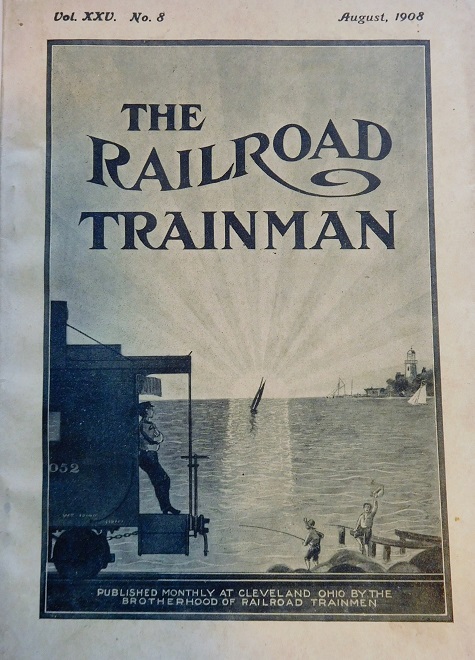 | |||
|
| Railway Historian IHC Life Member Site Moderator |
The directory listing shows that Lodge 783 Northwest Hub, Saskatoon, Sask meets on the 2nd and 4th Tuesdays of the Masonic Hall. A.J. Ryall was the Master, W.B. Goodfellow was the Secretary, and Albert Buchanan was the Financier. 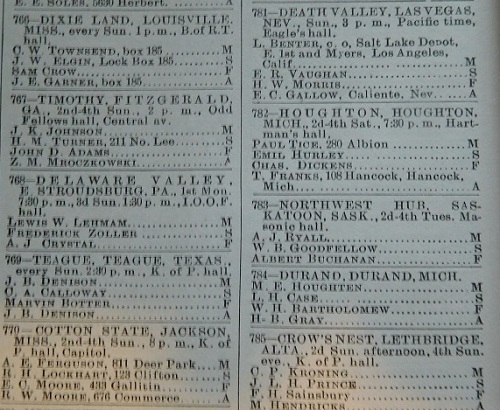 | |||
|
| Railway Historian IHC Life Member Site Moderator |
Cover of my Brotherhood of Railroad Trainmen Directory from 1939. | |||
|
| Railway Historian IHC Life Member Site Moderator |
The directory listing shows that Lodge 783 Northwest Hub Saskatoon, Sask. Meets on the 1st Sunday at 14:00, 3rd Sunday at 19:00 at the Odd Fellows Temple, 21st Street, East. W.E. Smith, 305 Albert Avenue was the President. J. Wedge, 620 – 29th Street was the Secretary. J. I. Nichol, 125 – 9th Street was the Treasurer, J.A. Taylor, 504 5th Street, East was the Receiver for insurance and he also served as the Lodges Local Chairman of the Canadian National Railways (Western Lines) | |||
|
| Railway Historian IHC Life Member Site Moderator |
Here Is An Employees Timetable from 1986 showing the Canadian National Railways Watrous Subdivision that ran from Mile 0 at Melville to Mile 247 at Biggar, Saskatchewan Saskatoon is at Mile 191. 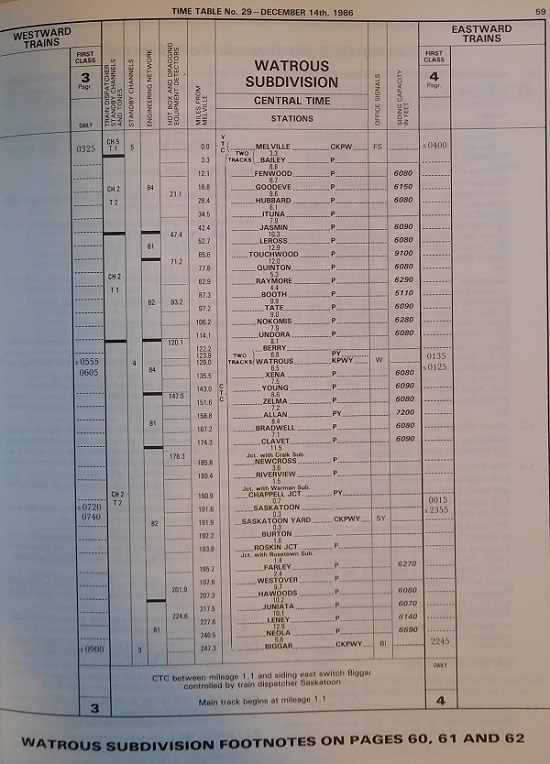 | |||
|
| Railway Historian IHC Life Member Site Moderator |
This is a map of Canadian Western Railway Lines from the 1970s many of these lines have been abandoned, the country elevators that was the heart of many of these communities are now gone, new super elevators that can load 100 cars of wheat overnight are the new modern ways of shipping grain. All the towns in blue are Canadian National Railways lines, and the ones in red are Canadian Pacific Railway lines. 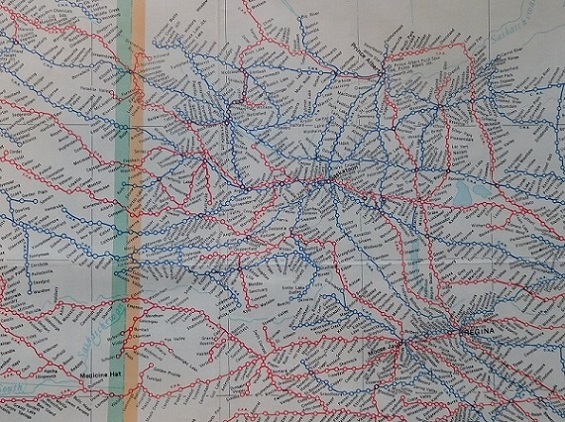 | |||
|
| Railway Historian IHC Life Member Site Moderator |
Here is one of my earliest dues receipts from E V Debs Lodge No.1 of the Brotherhood of Railroad Brakemen Lodge No. 1 was located in Oneonta, New York where the Brotherhood was founded on September 23, 1883. It is issued to Elmer Wessel one of the eight founding fathers of the organization and was an assessment of one dollar for his August dues in 1884 less than a year after its inception. Eugene Victor Debs was a great help in assisting the B of RT and getting started, financially and providing stationary, for this reason Lodge No. 1 was named after him. 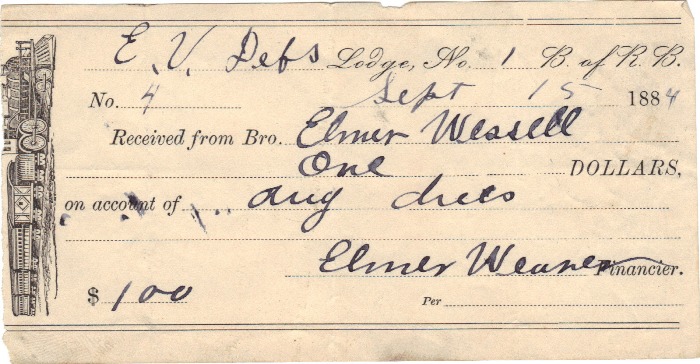 | |||
|
| Railway Historian IHC Life Member Site Moderator |
A Brotherhood of Railroad Brakemen Membership Certificate for John Slattery that states he is a Brother in good standing of Eugene V. Debs Lodge No. 1 signed at Oneonta, New York on May 2, 1884. 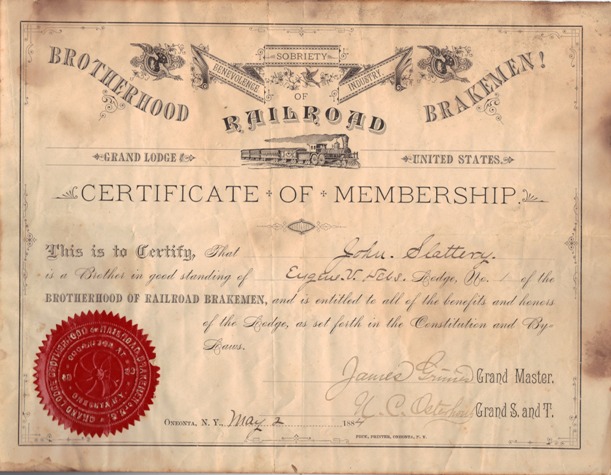 | |||
|
| Railway Historian IHC Life Member Site Moderator |
E V Debs was Eugene Victor Debs of Terre Haute, Indiana born in 1856, at an early age he joined Vigo Lodge of the Brotherhood of Locomotive Fireman, it was organized on December 1, 1873 in Port Jervis, New York by Joshua A. Leach and 10 other Erie firemen. The early B of LF took the form of the secret society, complete with an elaborate initiation ritual, adopted from Freemasonry. The initiation experience was memorable and effective in building lasting commitments to the organization. Three decades after his own initiation to the Brotherhood of Locomotive Firemen. Eugene V. Debs recalled the evening as a watershed in his life: "A new purpose and in my life, a fresh force impelled me as I repeated the obligation to serve the brotherhood.' and I left that meeting with a totally different and far loftier ambition that I had never known before" The first Grand Secretary and Treasurer was William Sayre who professed to be a staunch advocate of the theory of that personal virtue and good character, economic efficiency, and a stable and democratic republic were closely interrelated. While Sayre espoused the secret values on a theory plain, in practice his behaviour seems to have been rather more profane. In July 1880 a young fireman Eugene V. Debs was elected as Grand Secretary and Treasurer of the B of LF upon gaining access to to the books, Debs discovered that his predecessor had been embezzling funds from the organization. With the Brotherhood about $6000 in debt. Debs stabilized the organization's shaky finances with a promissory note which he personally backed and began a new era of careful financial management. Two years later the Brotherhood had recovered with nearly $13,000 in the bank to the credit of its 6000 members. A Travelling Card from 1891 from the Brotherhood of Locomotive Firemen signed by Eugene V Debs for a fireman Mr. P Martin a member of Smoky City Lodge 219, Allegheny Pennsylvania, Travelling Cards were issued, by Locomotive Engineers, Railway Conductors, Locomotive Firemen, and Railroad Trainmen moved down to for a period of 60 days for members that were furloughed, and were travelling in search of work., on the back side would be shown there number of years in service on road or yard. The member could use the card to introduce them to the members of other Lodges and Divisions, that could help them out, financially and accommodation with meals. These travelling cards were counterfeited as I will show a another thread sometime. 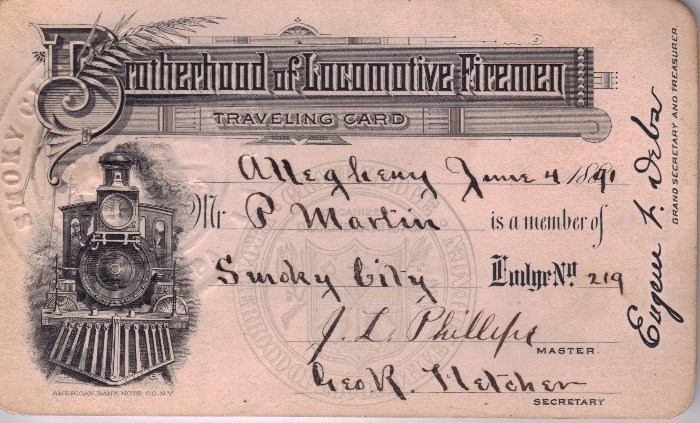 | |||
|
| Railway Historian IHC Life Member Site Moderator |
Debs was named the editor of the Locomotive Firemen's Magazine in 1881 and he remained in that capacity until September 1894. Debs seemed the limitations of a craft union and set out to start a true industrial union that would include of the railway workers from clerks to sectionmen. In 1893 he and other union men organize the American Railway Union in the United States and Canada. In 1893, the first railway he negotiated a contract with was James Jerome Hill's Great Northern Railway, they were successful and members of the other Big Four unions started joining the ARU. An American Railway Union membership card countersigned by Sylvester Keliher General Secretary, Sylvester had left the Brotherhood of Railway Carmen of America to join the ARU. The membership card was issued to J.M. Rector a member of Local Division No. 30 was employed as a Ticket Clerk on the Michigan Central Railroad. This worried both the General Manager's Association of the Railroads and the management of the Big Four railroad unions the Brotherhood of Locomotive Engineers, Order of Railway Conductors, Brotherhood of Locomotive Firemen, and the Brotherhood of Railroad Trainmen. George Mortimer Pullman the builder of railway sleeping coaches, and built a big factory in the south side of Chicago. Pullman was paternalistic and had built the town of Pullman around his factory, it was utopian with its library, churches, town hall and decent houses for the factory workers to live in. There was a severe economic depression called the Panic of 1893. The Pullman Palace Car Company cut wages as orders for passenger coaches dropped, there were layoffs and wages were cut, the delegation of workers complained that the wage cuts were too harsh, and that rents at the company town and other expenses had not been cut. The company owner George Pullman refused to lower rents or go to arbitration, with the workers facing starvation and seeing that the company had an internal short line railroad it entitled them for membership in the American Railway Union. Many of the Pullman factory workers joining the (ARU) led by Eugene V. Debs which supported their strike by boycotting Pullman coaches from passenger trains in Chicago. The plan was to force the railroads to bring Pullman to compromise. Debs began the boycott on June 26, 1894. Within four days 120,000 workers on 29 railroads had "walked off" the job rather than handle Pullman cars. The railroads coordinated their response through the General Managers Association,. The railroads began hiring replacement workers (strikebreakers) which increased hostilities. On June 29, 1894, Debs hosted a peaceful meeting to rally support for the strike from railroad workers at Blue Island, Illinois. Afterward groups within the crowd became enraged and set fire to nearby buildings and derailed a locomotive. Elsewhere in the Western states, sympathy strikers prevented transportation of goods by walking off the job, obstructing railroad tracks, or threatening and attacking strikebreakers. This increased national attention and the demand for federal action. 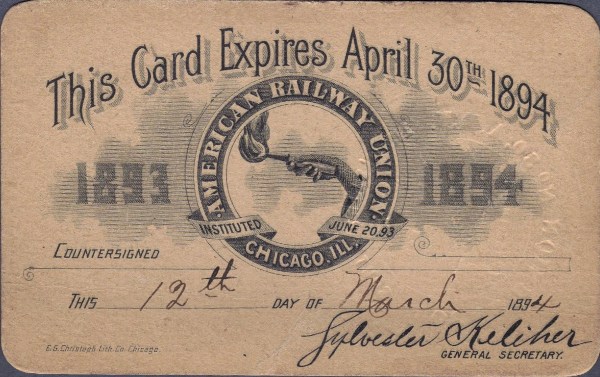 | |||
|
| Railway Historian IHC Life Member Site Moderator |
Reverse side of American Railway Union membership card, I also have one from 1894 to 1895 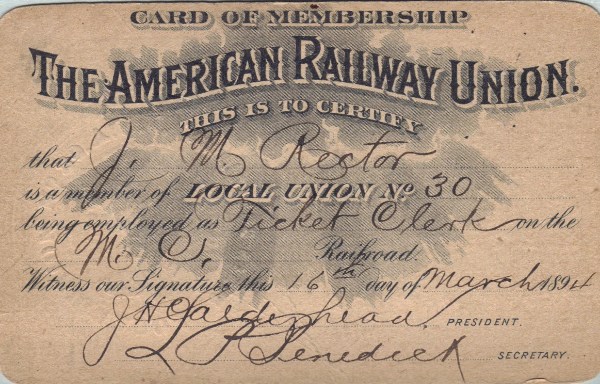 | |||
|
| Railway Historian IHC Life Member Site Moderator |
Under the direction from Democratic President Grover Cleveland, the US Attorney General Richard Olney dealt with the strike. Olney had been a railroad attorney, and still received a $10,000 retainer from the Chicago, Burlington and Quincy Railroad in comparison to his $8000 salary as Attorney General. Olney obtained an injunction in federal court barring union leaders from supporting the strike and demanding that cease their activities or face being fired. Debs and the leaders of the ARU ignored the injunction, and federal troops were called up to enforce it, under the protest of Democratic State Governor John Altgeld, Cleveland ignored his protests and send in the National Guard to break the strike. Aftermath Debs was arrested on federal charges, including conspiracy to obstruct the mail as well as disobeying an order directly to him by the Supreme Court to stop the obstruction of railways and to dissolve the boycott. He was defended by Clarence Darrow a prominent attorney. At the conspiracy trial Darrell argued that it was the railways, not Debs and his union, that met in secret and conspired against their opponents. Sensing that Debs would be acquitted, the prosecution dropped the charge when a juror took ill. Although Darrow also represented Debs in the United States Supreme Court for violating the federal injunction. Debs was sentenced to six months in prison. At the time of his arrest Debs was not a socialist. During his time in prison he read the works of Karl Marx. After his release in 1895, he became the leading socialist figure in the United States. He was a founder of the Industrial Workers of the World or "Wobblies" Eugene Debs was making an antiwar speech in Canton, Ohio on June 16, 1918. Democratic President Woodrow Wilson who called Debs "a traitor to his country" and had Debs charged with 10 counts of sedition and he was sentenced to 10 years in federal prison at Atlanta Georgia and was stripped of his citizenship. photo of Richard Olney 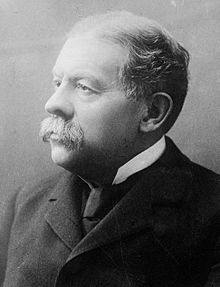 | |||
|
| Railway Historian IHC Life Member Site Moderator |
Eugene Debs presented what has been called is best remembered statement at his sentencing hearing: Your honour, years ago I recognized my kinship with all living beings, and I made up my mind that I was not one bit better than the meanest on earth. I said then, and I say it now, that while there is a lower class, I am in it, and while there is a criminal element, I am of it, and while there he is a soul in prison, I am not free. Woodrow Wilson would not give him a pardon, and Republican President Warren Harding on December 23, 1921 committee Debs sentence to time served. He died in Terre Haute, Indiana in 1926 at age 70. Labor Day in 1894, in an effort to conciliate organized labour after the strike, Democratic President Grover Cleveland and Congress designated Labor Day is a federal holiday. Legislation for the holiday was pushed through Congress six days after the strike ended. The name of the E V Debs Lodge No.1 B of RB was changed after the Pullman strike to Daniel F Hopkins Lodge No. 1 Brotherhood of Railroad Trainmen. Portrait of Eugene Victor Debs in 1895 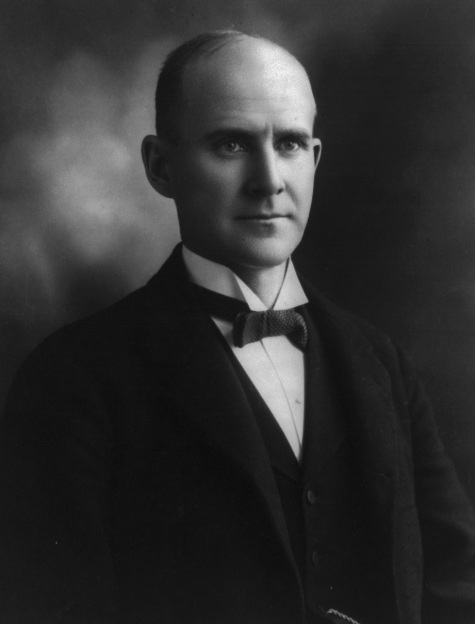 | |||
|
| Railway Historian IHC Life Member Site Moderator |
Talking about secret works and passwords here is a set from the Brotherhood of Locomotive Engineers from Lucerne Division 898, Jasper, Alberta. Lorne W. would have been a member of this Division during his career, I got them from Harry Home, they are from January and April 1956 when Harold Hempy was the Grand Sec. Treas. and Guy Brown was the Grand Chief Engineer. | |||
|
| Railway Historian IHC Life Member Site Moderator |
The other card. | |||
|
Hello Larry, I was hoping to hear from the Historian of all things Railroad, so very much appreciated. Thank you. I especially enjoyed the history account of Mr. Debs. He was there to champion a cause of the era and did so regardless of the consequences. The map of the Canadian Western Railway Lines reminded me of the spider web of gathering lines, distribution lines and mainline natural gas and oil lines in Alberta. Once again thank you for the history account. Rick | ||||
|
| Powered by Social Strata |
| Your request is being processed... |
|
Welcome Aboard IHC185™  Internet Horology Club 185
Internet Horology Club 185  IHC185™ Discussion Site Main Page
IHC185™ Discussion Site Main Page  Horological Discussions, Questions and Answers
Horological Discussions, Questions and Answers  Pocket Watch Discussions
Pocket Watch Discussions  Brotherhood of Railroad Trainmen, 1921 dues receipt
Brotherhood of Railroad Trainmen, 1921 dues receipt
 Internet Horology Club 185
Internet Horology Club 185  IHC185™ Discussion Site Main Page
IHC185™ Discussion Site Main Page  Horological Discussions, Questions and Answers
Horological Discussions, Questions and Answers  Pocket Watch Discussions
Pocket Watch Discussions  Brotherhood of Railroad Trainmen, 1921 dues receipt
Brotherhood of Railroad Trainmen, 1921 dues receipt©2002-2025 Internet Horology Club 185™ - Lindell V. Riddle President - All Rights Reserved Worldwide

